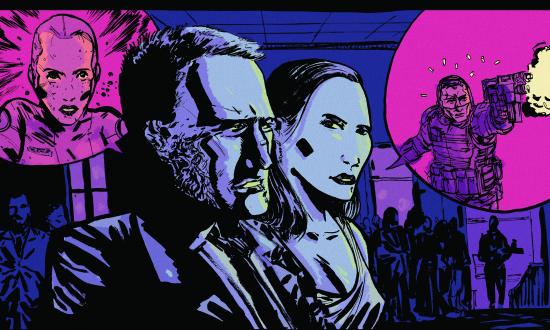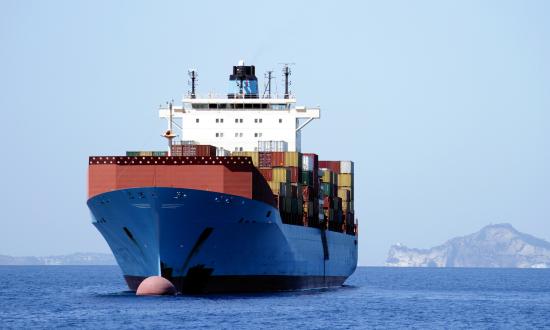The face of the adventurer at the steering-wheel, darkly visible ever and again by the oval greenish flow of the compass face, had something of that firm beauty which all concentrated purpose gives, and something of the happiness of an idiot child that has at last got hold of the matches. His companion, a less imaginative type, sat with his legs spread wide over the long, coffin-shaped box which contained in its compartments the three atomic bombs, the new bombs that would continue to explode indefinitely and which no one so far had ever seen in action.
The passage above is from The World Set Free by H. G. Wells. It describes two men, sitting in an airplane, preparing to drop an atomic bomb on Berlin. It details the fission-driven chain reaction that gives the atomic bomb its power by describing it as a bomb “that would continue to explode indefinitely.” In 1965, when describing his memories of successfully creating the most destructive weapon the world had ever seen, Robert Oppenheimer, a key member of the Manhattan Project, uttered a line from the Bhagavad Gita: “Now I am become Death, the destroyer of worlds.” Surprisingly, Wells wrote his novel in 1913, 25 years before fission was discovered and 32 years before the successful test of the atomic bomb in the New Mexican desert that inspired Oppenheimer’s haunting declaration from the Bhagavad Gita.
The discovery of the atomic bomb drastically altered the political climate of the free world.Prompting the conclusion of World War II, it brought a level of death and devastation to the Pacific never before seen by the human race. It was the driving force in the theory of mutually assured destruction that prevented the third world war. In describing the combined arsenal of the North Atlantic Treaty Organization in his 1962 “No Cities” speech, Robert McNamara defined this theory: “[W]e are giving a possible opponent the strongest imaginable incentive to refrain from striking our own cities.” Unfortunately, the adoption of the theory of mutually assured destruction was more than 20 years too late to prevent the colossal amount of death and destruction that occurred in World War II.
What if, when Wells wrote his novel in 1913, U.S. political and military leaders and their allies had used his fictional story to inspire discussion and wargaming, resulting in the development of the atomic bomb ten years earlier? Could the earlier introduction of such firepower and a quicker arrival to the theory of mutually assured destruction have saved some of the 50 million lives lost during World War II?
Fictional Intelligence
Wells’ science fiction novel, The World Set Free, was a harbinger to fictional intelligence, or FicInt. FicInt is “the combination of fiction writing with intelligence to imagine future scenarios in ways grounded in reality.” Since the coining of the term in 2015 by August Cole, coauthor of Ghost Fleet: A Novel of the Next World War, FicInt has developed a framework of guidelines that center around the “no vaporware” rule. Vaporware is technology that has been imagined, but is not yet created. To ensure that FicInt remains feasible and grounded in legitimate technology, all technology included in the story must be developed or in development. In addition, FicInt character behavior should be based on past real-world situations. Finally, FicInt should use appropriate facts and research to justify the narrative.Today’s warfare no longer starts and stops on land or even in the physical realm, yet much of the basic schooling and education in the military centers around these outdated concepts. The military must continue to evolve to combat and imagine future unknown threats to effectively protect our country.
FicInt is an effective way to communicate ideas and possibilities that have not been fully realized in the present world, but have the potential to be realized in the future world. In the military, it offers a way to “analyze and develop war scenarios from friendly, enemy, or neutral perspectives using real locations and emerging technologies.” Wells imagined a future world grounded in science. His writing could have inspired the U.S. government and military to discover solutions that would have given the Allies an upper hand in fighting the atrocities that were committed during World War II. In today’s world, imaginative and realistic writing could achieve the same end. FicInt is a tool grounded in research and realism, which could be leveraged by all levels of the military—strategic, operational, and tactical—to visualize potential threats to our country.
FicInt and Reality
In 2020, the United States faced a pandemic, protests, fires, riots, death, war, climate change, political conflict, and more. While the government has done its best to react to these challenges, the response often has been too little too late. The United States must do a better job of anticipating potential threats that could adversely affect the nation. Similarly, the Marine Corps is constantly training to carry out any mission with which it is tasked, but too often the service is preparing to face the threats of the past and present. The Marine Corps must also train and equip to stem the threats of the future. Amid the rapid advance of technology in the modern world, FicInt will allow the Marine Corps to leverage the imagination and creativity of the entire service to anticipate the challenges of tomorrow.
In his Commandant’s Planning Guidance, General David H. Berger’s declares “significant change is required to ensure we are aligned with the 2018 National Defense Strategy (NDS) and DPG [Defense Planning Guidance], and further, prepared to meet the demands of the Naval Fleet in executing current and emerging operational naval concepts.” While the short timeframe of most formal academic Marine Corps courses makes it impossible to explore all emerging types of warfare, critical thought about how warfare is changing and has changed must be incorporated into the curriculum. In today’s interconnected and constantly changing world, it is no longer enough to learn the baseline and accept current conventions. The Marine Corps must find ways to challenge its warfighters to think outside the box to better prepare for future conflict.
When Ghost Fleet was published in 2015, the startling feasibility of its storyline caught the attention of the military intelligence community. The authors, P. W. Singer and August Cole, both writers with a background in the defense industry, explore a world in which everything is recorded and most technology has been weaponized. While the book is a captivating story, it also offers an exercise in critical thought and imagination to its readers. By combining an understanding of warfare today with their understanding of evolving technology, the authors were able to use their imaginations to create FicInt that effectively communicated the threat they envisioned. For example, in Ghost Fleet, China successfully carries out a supply chain attack to tamper with U.S. technology. When Bloomberg Businessweek reported a potential supply chain attack on the United States in 2018, Ghost Fleet was prominent in much of the reporting on the incident to explain a supply chain attack to the common reader. Not only did the book effectively explain the attack to a non-tech audience, but, more importantly, the authors accurately predicted that a threat of this nature would eventually surface in the United States.
FicInt in Marine Corps Schoolhouses
The Marine Corps has used FicInt selectively in the past, notably in 2016 when the Marine Corps Warfighting Lab joined with the Atlantic Council in a science fiction workshop with the authors of Ghost Fleet and other science fiction novels. However, the Marine Corps should pursue FicInt in a broader way. Marine Corps schoolhouses can use FicInt to challenge both officers and enlisted personnel to prepare for the unanticipated by imagining the future while still applying the fundamentals of maneuver warfare that are central to the Marine Corps. Moreover, FicInt created by Marine students would provide company-grade officers and junior enlisted an avenue to communicate their thoughts on potential threats up the chain of command. Students at schoolhouses such as The Basic School or Corporals Course could be tasked to write a short FicInt story in response to a prompt or exploring a topic of their choice. Similar to a sand table exercise, these stories could be shared among fellow students and wargamed to encourage further exploration of ideas that exist past one’s own imagination. Stories that are particularly jarring and relevant could be passed up the chain of command for the consideration of higher echelons.
Not only would the use of FicInt in schoolhouses allow for a broader assemblage of knowledge and creativity in considering possible threats, but it would also assist the Marine Corps in bridging the gap between generations. Currently, the senior enlisted, field grade, and general officers of the Marine Corps did not grow up with technology as a central part of their lives. Today’s junior enlisted and company grade officers are digital natives who operate with technology as a fifth limb. This younger generation may more intuitively and readily understand how technology can be weaponized. In using FicInt as a way to convey those possibilities, the Marine Corps can ensure it is considering as many possible future threats as they can.
“FicInt is a tool for analysis, explanation and prediction, and just like SigInt and HumInt; it’s not the only tool. It’s not just telling a story. It’s not sci-fi. There are rules to FicInt and most important of these is that it’s a combination of narrative world-building and real research,” says Ghost Fleet co-author, Peter Singer. Going forward, Marine Corps schoolhouses must leverage FicInt to ensure that the service is not training to fight the last war, but instead training for the future of conflict. It is a means of communicating ideas and scenarios that could happen in the future, and it allows the Marine Corps to identify and prepare for these possibilities and to effectively take on the threat in the information space. The world is constantly changing, and it is changing faster than ever before. Technology offers us an advantage in future conflict, but only if we can visualize that advantage and conflict before it happens.






